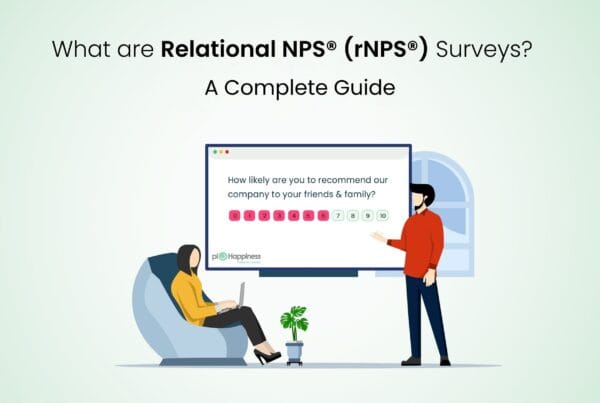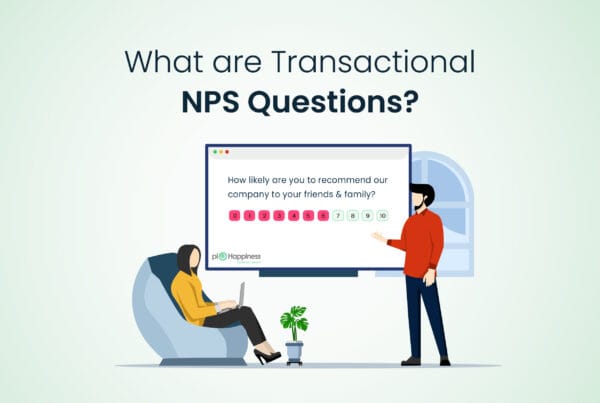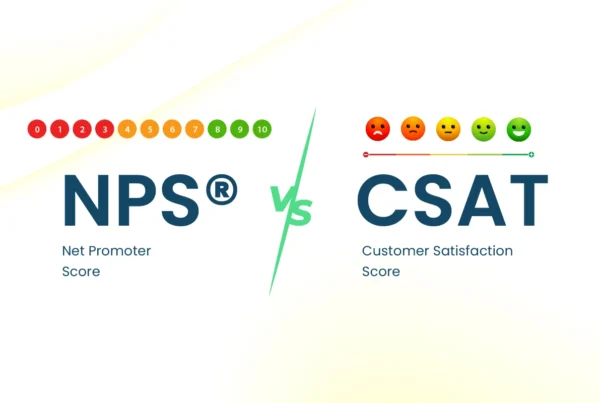Net Promoter Score is the most important metric to measure customer loyalty and overall satisfaction with the brand.
Accordingly, it is essential to utilize NPS® surveys at various touchpoints all through the client journey. Also, it is encouraged to conduct NPS® surveys using a NPS survey platform through various channels relying upon where your clients decide to interact with your business.
Discover what an NPS survey is and how it can boost your customer insights.❤️
Learn more and start improving today with piHappiness!
For all of this, here we have put together a detailed article that covers creating surveys using an NPS tool, types of NPS surveys, and the channels you can conduct NPS surveys over.
What Are Net Promoter Score Surveys?
A Net Promoter Score® review comprises of questions pointed toward checking clients’ devotion to the brand. It prompts clients to rate how likely they would prescribe your business to others on a size of 0 to 10.
- Clients who give a score of 9 or 10 are Promoters. They are extremely faithful to the organization and are probably going to recommend it to other people.
- Clients who give a score of 7 or 8 are Passives. They are not genuinely faithful to the brand and may switch whenever given a superior choice.
- Clients who give scores of 0-6 are Detractors. They are not fulfilled and faithful to the organization and may try and badmouth it.
To make your NPS survey more elaborate you can always ask follow-up questions.
Further, this will help you understand the reason behind the scores that customers have chosen to give.
Following are the few examples of NPS questions while you’re looking to understand the sentiment of customers towards your brand:
- What was the justification for the score you decided to give us?
- What might we at any point improve to work on your experience with us?
- What were the difficulties you experienced while doing business with us?
What are Different Types of NPS Surveys?
NPS surveys can be employed in different ways, which gives us two types of NPS surveys:
Transactional NPS surveys and Relational NPS surveys.
Transactional NPS surveys: Transactional surveys are sent after a specific interaction or transaction or occasions like making a payment, putting in an order, booking tickets, and so on. NPS surveys are set off on an occasion and are intended to comprehend clients’ dependability based on the new exchange rather than the clients’ relationship with the brand in general.
Here’s an example of transactional NPS survey question:
“Depending on your current buying experience, how likely are you to recommend shopping on our website to your friends and colleagues?”
Relational NPS Surveys: A relational NPS® survey is sent at fixed intervals in a client venture and is intended to comprehend clients’ devotion to the brand as a whole rather than in light of a particular transaction. For the most part, relational NPS® surveys, using NPS survey software are sent bi-annually, quarterly, or yearly.
How To Send NPS Surveys?
NPS® surveys can be conducted on various channels in light of your clients’ accessibility and decision of platform for interaction. Here are various ways you can send NPS® overviews:
NPS Email Surveys
NPS surveys can be sent through email to clients personally or it can be automated to be sent to a group of customers. Again, this depends on when to send NPS surveys in a customer journey. For example, transactional NPS® surveys are set off exclusively after an event, and relational NPS® surveys can be shipped off to a group of clients, depending upon where they are in their client lifecycle.
Here are a few types of email surveys you can depend on:
Email Signature NPS Surveys:- Email signature surveys are embedded directly in the signature of an email and can be sent as a part of ongoing communication. These types of surveys can dramatically increase the response rate since customers will be able to answer the survey question during the support interaction without having to go to a survey landing page.
Email Embedded NPS surveys: – You can easily embed NPS surveys directly into the email body with the help of Email Embed Survey feature in your survey software. This allows customers to respond to an NPS survey directly in the email body, thus increasing a high chance of customers sharing their responses.
Email embedded surveys can be sent personally after a resolution or interaction with customers or to a group of customers so as to understand customers’ perception of the brand as a whole.
Email Button or Link Surveys: – NPS surveys can be embedded in a button that can later be added to the email body, which when clicked, takes participants of the survey to the landing page. In a similar way, NPS survey link can also be sent to hundreds and thousands of customers in a single go.
NPS Website Surveys
NPS surveys on website are very important only if you sell your products or services online. This helps in capturing NPS responses even from customers who are not able to take time to open email surveys to share feedback.
Moreover, website NPS surveys help in collecting generalized website feedback also from those people who haven’t shared their contact details with you yet.
Here are a few different ways to website surveys to measure Net Promoter Score:
Popup NPS Surveys: – Pop up surveys are types of survey that pop up when an event trigger condition is met. Suppose for example, they can pop up right after a customer place an order. The survey questions in these types of surveys can be modified as per the event to collect relevant feedback.
NPS Website Embedded Surveys: – NPS surveys can directly be embedded into the web pages of your website. This is great when you are looking to gather generalized feedback. For example, this survey can be inserted at the bottom of your homepage to understand if visitors would recommend your brand depending on the browsing experience.
NPS Feedback Button: – Feedback buttons are those that can be placed on any page of your website so as to collect specific NPS data. A feedback button, when clicked, will take the survey participant to the survey landing page.
You will be able to decide strategically where to insert NPS survey buttons on your website depending on what your feedback goals are.
Using Survey Integration With Customer Ticketing & Servicing Tools
Your customer support will be able to collect feedback from customers directly while they are still interacting with the agents using survey integration with customer ticketing and servicing tools, such as Zendesk, Freshdesk, Intercom, etc.
Survey software integration allows sending NPS surveys in ongoing communication through email & chat. This allows clients to share their responses in the form of feedback, right in the chat window and email without having to open the survey separately.
The advantage of this is that clients would be bound to take the survey since they are as of now talking with the support executive in a similar window. It likewise clears a path for real-time feedback and assists in gathering insights while the help with support experience is still new in clients’ brains.
NPS SMS Surveys
SMS surveys consist of survey links, which when clicked, take the respondents to the survey landing page. Though SMS surveys are easily accessible, the survey participants must have an internet connection to take the survey, just like other online surveys.
Although SMS surveys are easily accessible, the survey participants must have an internet connection to take the survey, just like other online surveys.
NPS QR Code Surveys
NPS surveys can be embedded in QR codes, so when they are scanned, it would open the survey page. QR codes with embedded surveys can be printed on various materials such as food packaging, menus, invoices, tent cards, instruction manuals, etc., and also at different touch points in a retail store.
This permits brands to conduct transactional NPS surveys using a NPS survey tool so as to understand customers’ loyalty to the brand after a certain event. Let’s say for example a client can scan the QR code at the exit or charging point in a retail score to share in the event that they would prescribe the brand to others based on their shopping experience.
The simplicity of sharing feedback through QR code surveys can decisively build the review cooperation rate and furthermore give brands admittance to new, veritable criticism.








